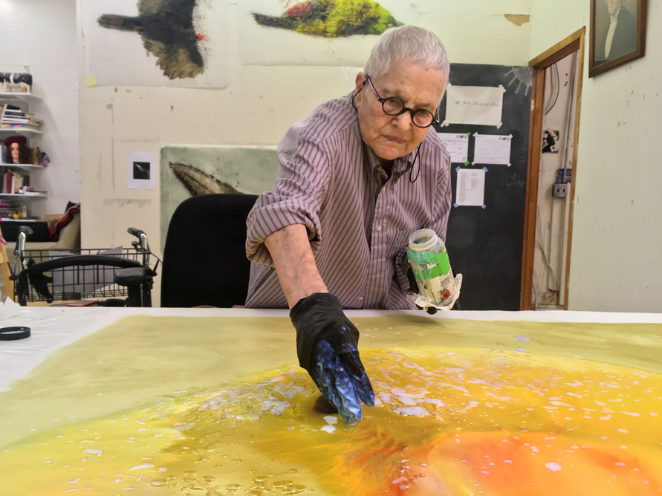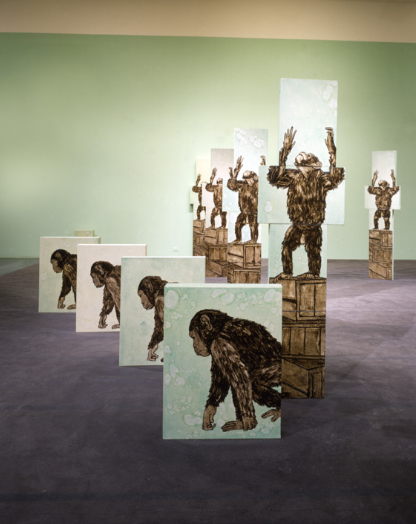In Memoriam: Ida Applebroog
(1929 – 2023)
Press Release

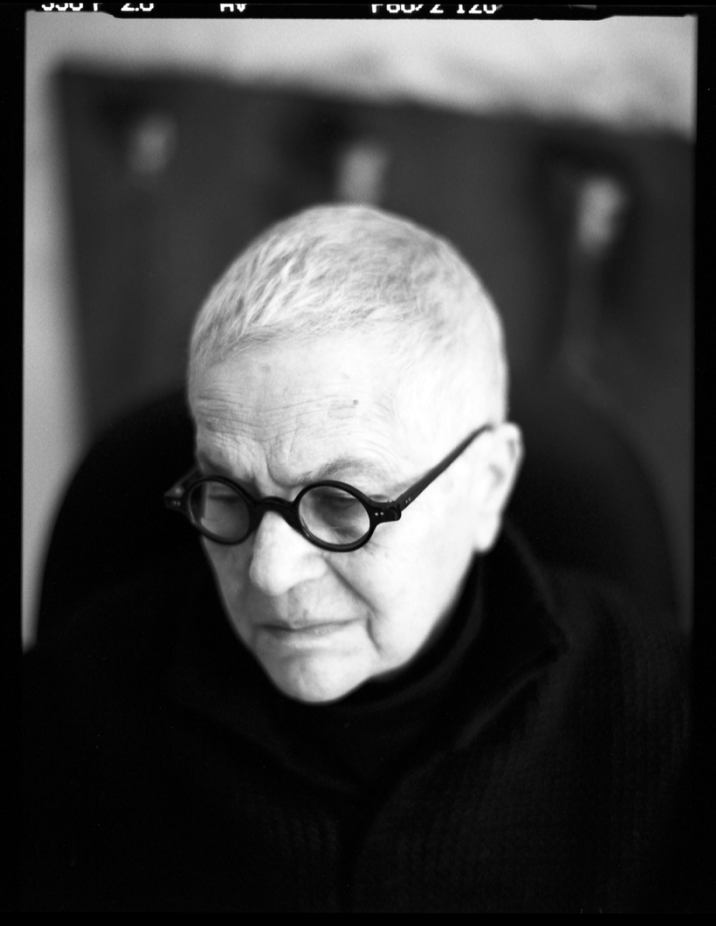
‘One accepts it – the inevitably of life. I have no answers!’ – Ida Applebroog
It is with great sadness that Iwan and Manuela Wirth and Marc Payot, co-presidents of Hauser & Wirth, confirm the passing of American artist Ida Applebroog at age 93 in New York. She is survived by her four children and their families.
Born in the Bronx in 1929, Ida Applebroog emerged from the vibrant arts scene in SoHo, New York in the 1970s. Her daring and disturbing works have ranged in medium over more than six decades of practice, including artists books, painting, drawing, sculpture, film and installation, but have persistently been concerned, as the artist once said, with ‘how power works—male over female, parents over children, governments over people, doctors over patients.’ Best known for drawn and painted scenes on Rhoplex- coated vellum, depicting flat, sometimes headless, often nude human figures rendered in cartoonish, simplified lines, Applebroog’s works created an ambiguous atmosphere and uncertain narratives. An early pioneering feminist who declared herself an ‘image scavenger’ and ‘generic artist,’ Applebroog cribbed references and images from mainstream media such as television, comics and fashion magazines to grapple with the construction of image and its impact on individuals and their social interactions, always with an acerbic eye and razor sharp wit.
Manuela Wirth, President Hauser & Wirth, commented: ‘Ida has been a powerful force within the feminist movement since the 1970s, forging her own unique identity as an artist and woman, mother and wife. Relentless in her capacity for expansive visual experimentation, she interrogated themes of violence and power, human relations, her own body and domestic space. Her emotionally disruptive and fearless approach to making art has been an inspiration to many generations, intensely personal, honest and raw. We are eternally grateful for her humour, wit and radical introspection, presenting the absurdities of life as it is. Our thoughts are with Ida’s children and her extended family and friends at this time. She will be deeply missed by so many.’
Applebroog began to produce bold line drawings referencing the comic-strip style favoured by the advertising industry at the time. In 1977, she made her first artist books from her darkly humorous vignettes and sent them in the mail to a list of 500 artists and writers. In this period, she also made her first film, using puppets, ‘It’s No Use Alberto’ (1978), shown at the Whitney Museum of American Art in 1978. Her approach to translating the language of illustration into moving image and other forms, as well as staging two-dimensional drawings and paintings as installations—suspending canvases in space, stacking them, or arranging them in unconventional ways in space—is another of her enduring legacies.
In 1981, Applebroog held her first solo exhibition with Ronald Feldman Fine Arts in SoHo, New York; she was represented by the gallery until 2007. Applebroog joined Hauser & Wirth in 2009 and her first solo exhibition took place at Hauser & Wirth New York in 2010. Active into her 90s, her late works continued to explore notions of beauty, the mechanics of desire and feminism.
Applebroog’s most recent exhibition took place at Hauser & Wirth Somerset in 2022, ‘Ida Applebroog. Right Up To Now 1969 – 2021,’ including a new body of mixed media work, continuing to express her concerns with violence, freedom, beauty and nature but always posing more questions to the viewer, rather than providing the reassurance and safety of answers. Applebroog’s endless curiosity and the urgency of her interrogation of the world inspired works that were simultaneously of their time and timeless.
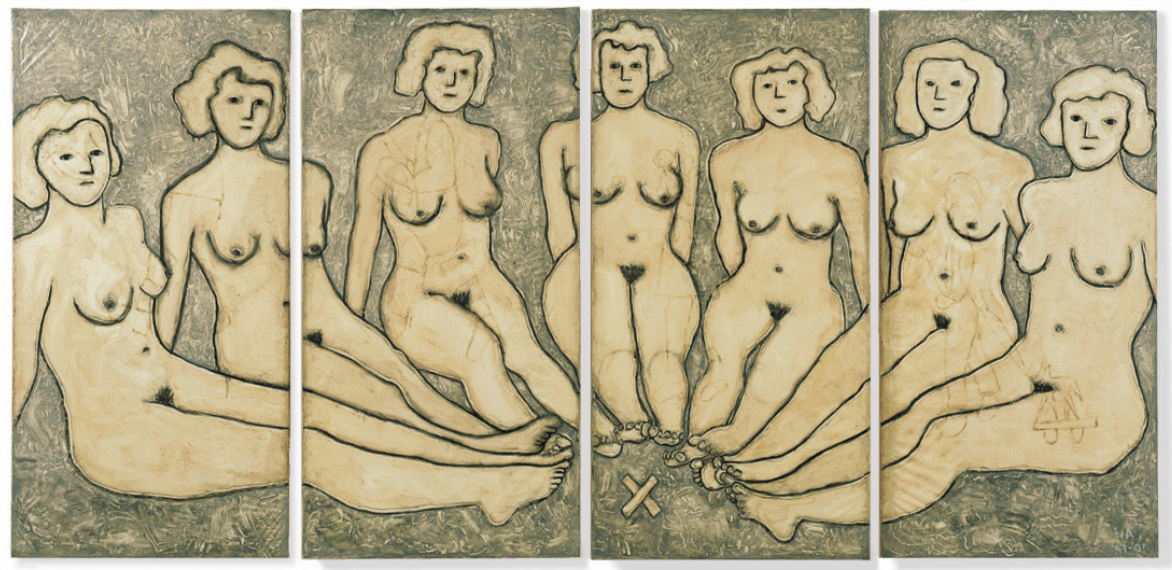
Biography
Ida Applebroog was born Ida Applebaum in the Bronx in 1929. She was raised in an ultra-Orthodox Jewish family and grew up in a tenement in the Bronx with her two sisters and parents, both immigrants from Poland. Her mother was a dressmaker and her father, a strict authoritarian who she described as threatening, was a furrier. In 1948, Applebroog embarked on studies in graphic design at the New York Institute of Applied Arts and Sciences. As a student, she worked as the only woman at an advertising agency where she encountered daily sexual harassment. She left after six months and continued to work as a freelance illustrator.
In 1950, Applebroog married Gideon Horowitz, who she had known since childhood. The couple had four children by 1960. The family relocated to Chicago where, between 1965 and 1968, Applebroog attended the School of the Art Institute of Chicago. In 1968, the family relocated again to San Diego where Applebroog completed what would become one of her most significant bodies of work: 150 line drawings of her vagina made in her bathroom at home. Applebroog said that the drawings were exploratory but not in a sexual sense, that she made them in the hope of finding specimens of herself ‘hidden away someplace.’ Although the works were not shown in public until her first solo exhibition at Hauser & Wirth New York, ‘Monalisa,’ in 2010, this private, ritualistic act was an act of reclamation and rebellion against the exploitation and misrepresentation of women’s bodies that continued to preoccupy later works.
Applebroog was hospitalized for several weeks following a nervous breakdown in 1969. When she was released, she began making soft, abstract sculptures in muslin inspired by Claes Oldenburg; her first solo exhibition took place in California in 1971 and presented these works; all of the sculptures were later destroyed.
Applebroog’s involvement with the feminist movement in the US began after she attended the Feminist Artists Conference at the California Institute of the Arts in 1972. In 1974, Applebroog returned to New York, taking up a studio in SoHo. She adopted the name ‘Applebroog’—the beginning of a bold reinvention as a woman and as an artist. In 1976, she joined the Heresies Collective, alongside artists including Lucy Lippard, Joan Snyder and Pat Steir. Applebroog contributed to the collective’s publication, ‘Heresies: A feminist publication on art and politics.’
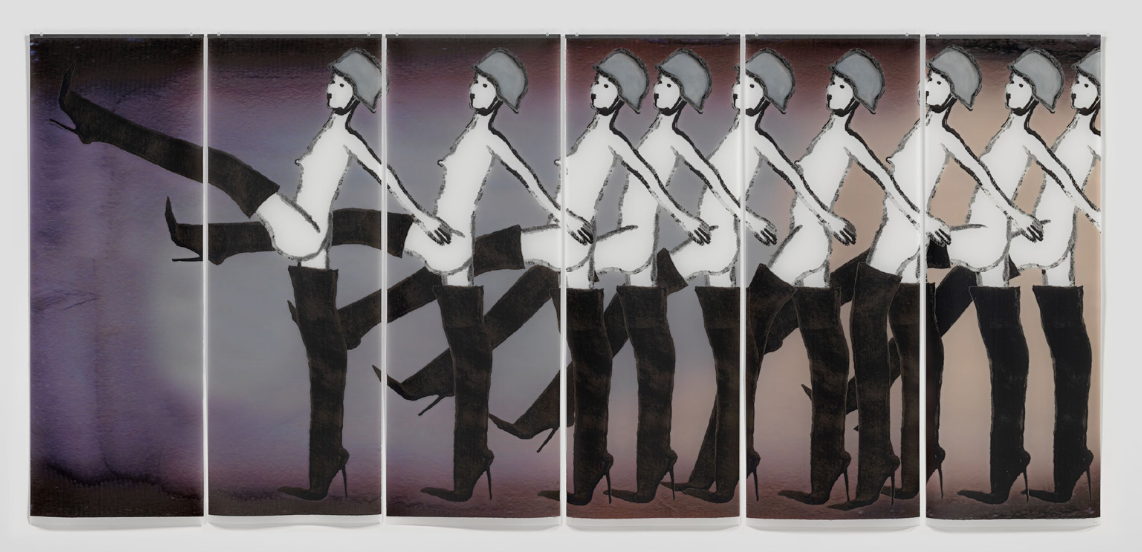
In the 1970s, Applebroog developed her simple, bold line drawings of cartoonish figures on Rhoplex-coated vellum; reminiscent of a storyboard, these characters are often framed by windows, curtains or screens, demonstrating Applebroog’s interest in the theatre of the domestic, dramatising everyday moments and giving intimate glimpses into communication breakdowns between men and women.
From 1981, Applebroog was represented by Ronald Feldman Fine Arts for over 25 years and, from 2009, was represented by Hauser & Wirth. She exhibited extensively across the US and Europe. Pivotal bodies of work include ‘Modern Olympia’ (1997-2001), in reference to Manet’s painting, in which she reclaimed the female gaze, freed female sexuality from exploitation and shame and addressed themes around ageing and beauty. ‘Photogenetics’ (2005) pushed her ideas on portraiture further; the series of mixed-media portraits was created via a complex process of clay modeling, photographing, printing and painting, resulting in haunting, ghoulish images. ‘The Ethics of Desire’ (2014) shifted Applebroog’s trademark figures into large scale—to over nine-feet-tall Mylar pieces suspended and dramatically lit. Applebroog continued to find new modes and languages throughout her career and to look to her surroundings for unexpected subjects, shifting again with the late body of work ‘Angry Birds of America’ (2019), in which she made sculptures, drawings and paintings of dead birds as a way to symbolise the violence of the Trump era in the US.
Applebroog won many major awards and accolades: in 1995, she was awarded the Lifetime Achievement Award from the College Art Association and in 1997 she was received an Honorary Doctorate by Parsons School of Design, New York. In 1998, she was a recipient of the MacArthur Foundation Fellowship. In 2008, Women’s Caucus for Art presented Applebroog with the Lifetime Achievement Award and, the following year, in recognition of her achievements, she received the Anonymous Was a Woman Award. Applebroog’s work is held in the permanent collections of the Whitney Museum of American Art, New York NY, the Solomon R. Guggenheim Museum, New York NY, and the Museum of Modern Art, New York NY.
Major international exhibitions throughout Applebroog’s career include The Brooklyn Museum, New York NY (1983 and 1994) the Contemporary Arts Museum, Houston TX (1990), Pennsylvania Academy of Fine Arts, Philadelphia PA (1998) and the Corcoran Gallery of Art, Washington D.C. (1998). She participated in documenta in 1987 and 2012. Recent major exhibitions include Institute of Contemporary Art, Miami FL (2016) and a comprehensive retrospective at the Reina Sofía Madrid, Spain (2021).
Applebroog's paintings from the early 1990s are included in Hauser & Wirth’s forthcoming group exhibition ‘RETROaction,’ opening at its Upper East Side location on 69th Street in November and traveling to Downtown Los Angeles in February. The exhibition is developed in collaboration with Homi K. Bhabha, Charles Gaines and Ellen Tani on the occasion of the 30th anniversary of two landmark exhibitions in the United States: 'Theater of Refusal: Black Art and Mainstream Criticism,’ initiated by artist Charles Gaines in Irvine CA, and the 1993 Whitney Biennial in New York NY.
IdaApplebroog_Obituary_PressRelease.pdf
PDF 1.5 MB
For messages of condolences to be passed onto Ida Applebroog’s family, please email: condolences@hauserwirth.com
Press contacts:
Chloe Kinsman, Hauser & Wirth, chloe@hauserwirth.com, +447780904011 (EU)
Laura Cook, Hauser & Wirth lauracook@hauserwirth.com +44 7920 414 876 (EU)
Andrea Schwan, Andrea Schwan Inc., andrea@andreaschwan.com, +1 917 371 5023 (USA)
Caption and courtesy information:
All images:
© Ida Applebroog
Courtesy Hauser & Wirth
Ida Applebroog, 2011
Photo: Emily Poole
Ida Applebroog in her studio, 2018
Photo: Emily Poole
Ida Applebroog
Monalisa
2009
Gampi, mylar, ink, pigment, oil, watercolor and wood
279.4 x 365.8 x 372.1 cm / 110 x 144 x 146 1/2 in
Photo: Alex Delfanne
Ida Applebroog
Modern Olympia (After Manet)
1997-2001
Oil and charcoal on gampi mounted on canvas; 4 panels
Overall: 186.4 x 376 cm / 73 3/8 x 148 in
Ida Applebroog
Galileo Chronology: I'm dying
1975
Ink and lacquer on mylar, 4 panels
Overall: 170.8 x 220.3 cm / 67 1/4 x 86 3/4 in
Photo: Ken Adlard
Installation view, 'Ida Applebroog. Everything is Fine', Brooklyn Museum, New York NY, 1993.
Ida Applebroog
Everything is Fine
1990-93
Oil and resin gel on canvas; 21 multi-panel paintings; 47 total panels
Overall installation size: 10.67 meters 21.6 cm x 10.67 meters / 35 feet 8 1/2 in x 35 feet
Ida Applebroog
The Ethics of Desire
2013
Ultrachrome ink on mylar; 6 panels
Overall: 299.2 x 652.8 cm / 117 3/4 x 257 in
Photo: Genevieve Hanson
Ida Applebroog
Portraits (Cardinal)
2019
Ultrachrome ink and gel on mylar 134 x 121.9 cm / 52 3/4 x 48 in
Photo: Emily Poole
Installation view of ‘I See By Your Fingernails That You Are My Brother: Journals’ (1969-2011), dOCUMENTA (13), Kassel, Germany, 2012. Photo: Roman März.
Ida Applebroog
I See By Your Fingernails That You Are My Brother: Journals
1969-2011
Ultrachrome ink, paint, mylar, paper, wood, cardboard, metal racks, screen print on gessoed art board, velcro
76.2 x 127 x 30.5 cm / 30 x 50 x 12 in approx. installation size
